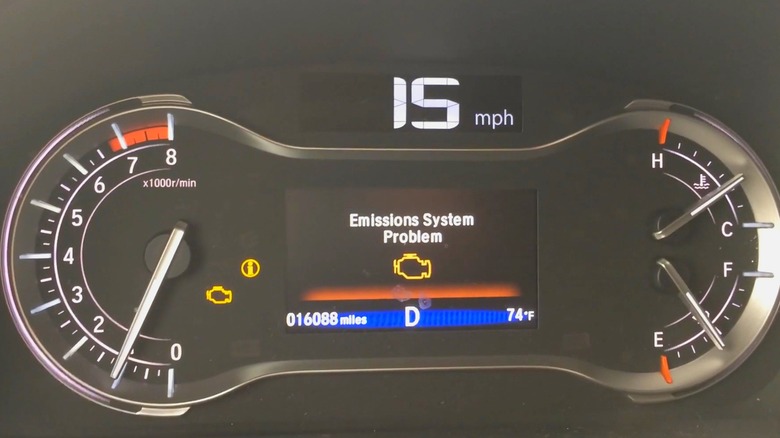This Is What It Means When Your Honda Pilot's Emissions System Light Comes On
Hondas are known for their reliability, but like any other complex machine, they can run into the occasional issue. One of these is the dreaded "Check Emission System" or "Emissions System Problem" warning light that may pop up on the dashboard. It can be alarming due to its vagueness, which often leaves drivers wondering whether they need to call for a tow.
Of course, this isn't just an arbitrary alert. It's the car's onboard computer telling you something is off with the emission control system — the network of parts responsible for keeping your vehicle's exhaust clean. This is critical not only for maintaining air quality but also for passing state-mandated emissions inspections — though, it's worth noting that not all states require regular car inspections.
Compared to second and third generations, the new Honda Pilots in particular have had their emission systems beefed up with tech like Variable Cylinder Management (a system that selectively deactivates cylinders) and direct fuel injection. While these upgrades improve efficiency, they also add complexity — and with that, more things that can go wrong. Let's dive into what the warning means.
Common symptoms to look for
In terms of providing answers, the check engine light itself doesn't offer any real detail. If you can't identify the check engine light simply by popping the hood, you'll need to plug in a car diagnostics tool like an OBD-II scanner to pull up diagnostic trouble codes (DTCs). These codes can pinpoint whether you're dealing with something like a misfiring cylinder or a failing oxygen sensor.
One major red flag that may manifest ahead of or after that warning light flashes is reduced fuel efficiency. This is a telltale sign that the emissions system isn't optimizing combustion the way it should. You may also notice unusual exhaust smoke — thicker, darker plumes or even a strong smell. That could mean the catalytic converter isn't processing exhaust gases correctly.
Another indicator is a rough idle, where the engine feels shaky or unstable while idling, which often hints at deeper issues within the emission control setup, like clogged fuel injectors or problems with the mass air flow (MAF) sensor. In more serious cases, the engine might start to misfire, which can damage the catalytic converter and cylinder walls if not dealt with quickly. Ultimately, any or more than one of these issues can lead your Pilot to fail its emissions test.
How to address emissions system problems
To address an issue with the emissions system, you'll need to check each code pulled from an OBD-II reader and search what it means on the internet or your car's manual. The codes will reveal whether you're dealing with a minor fix like an oxygen sensor or something more serious like a VCM unit or failing injectors. Smaller issues — say, a bad O2 sensor or a loose gas cap — can be tackled at home. But anything involving the cylinder deactivation system or high-pressure fuel pump (HPFP) is best left to a mechanic.
Third-generation Honda Pilots, especially model years 2016 to 2018, are prone to fuel injector and HPFP failures. The 2016 Honda Pilot, in particular, has drawn attention. We've even flagged these cars for such issues in our breakdown of used Honda models to avoid at all costs. Honda has acknowledged some of the problems by issuing technical service bulletins, too, but these aren't recalls. That means if your warranty expires, expect to shell out several hundred dollars for repairs. For instance, a CarBuzz report highlights that a failed HPFP alone costs around $600 just for the part. Then there's the VCM system — a known troublemaker on earlier Pilots — which can lead to oil leaks and even internal engine damage if ignored. Replacing the VCM gasket and solenoid can cost over $500 with labor. The bottom line is that you shouldn't ignore that warning light. Continued driving with emission system problems can reduce performance and snowball into serious damage.


